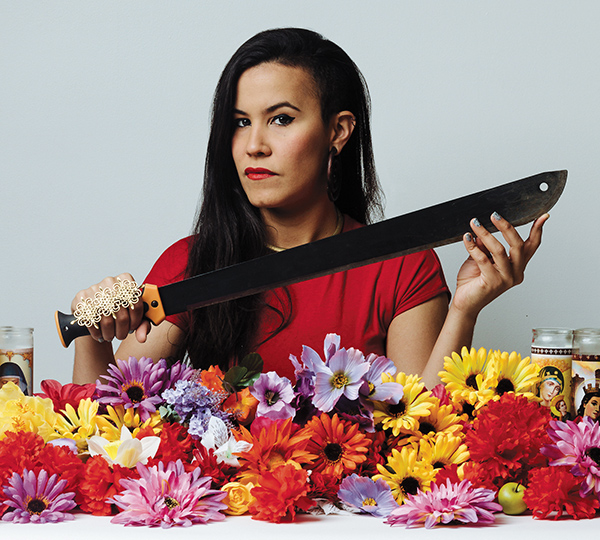Shey Rivera

When I reached out to arrange a studio visit with Shey ‘Ri Acu’ Rivera Ríos, they remarked but “I’m not working from a studio right now.” The artists’ studio is a space of so much mythos, from Matisse’s fauvist dream of The Red Studio, to Warhol’s Factory. Yet the studio is not a given, nor a requirement, for artmaking. Instead, how do we relate to place, in both its mythos and its practicalities. How does where we are impact what we build, and how do we build where we are?
Rivera Ríos was born and raised on the island of Borikén (Puerto Rico) and has lived in Providence, RI, land of the Narragansett and Wampanoag, for more than a decade. Puerto Rico is a leitmotif of their work, often visualized through the landscape of the island, including the rivers of their name. In our conversations, Rivera Ríos echoes what is familiar for many people in diaspora, that there is grief around the idea of home. And, while the island is always present in their work, Providence is their home base: “You really have to commit to a place if you want to build something.” Rivera Ríos understands why people ask if they’ll “ever go back” to Puerto Rico, but point to how the question uncomfortably insinuates another: “Will I ever just belong here?”
Rivera Ríos is best known for installations and performances rife with imagery simultaneously nostalgic and futuristic, satirical and earnest, but with years of nonprofit work from arts organizations to city planning committees their practice centers place-building and tending. Increasingly, Rivera Ríos’ considers how their relationship to Puerto Rico shows up not just through iconography, but in their embodiment of lineage(s).
AntigonX, performed at the Wilbury Theater in 2022, retells the canonical Greek tragedy through a queer lens, exploring Puerto Rican experiences in current sociopolitical upheaval. As a character who struggles against rigid constructions of justice, Antigone is already a queerly resonant figure, but AntigonX emphasizes the relationship of sister Ismene (she/her) and Antigoná (they/them), imagining a collaborative, dialogical context denied Euripides’s protagonist. By fleshing out the relationship implicated in the ambiguous X of AntigonX, Rivera Ríos’ performance doesn’t propose a revisionist, utopic ending (though the set design featured electrified platanos flowers as cyber-portals), but animates the blessed practice of productive disagreement in community. Their futurist vision is not rooted in as-of-yet unknown techno-innovations, but in what we can do and are doing now, to survive the present moment in place.

Rivera Ríos notices a trend towards catharsis in much contemporary performance, but they are more interested in embodied surviving/thriving, often through ritualistic connection to lineages of both human and nonhuman kin. In their most recent performance, On capturing water (2023), they methodically cut a five-gallon bucket worth of rose petals with their machete amidst a projected scene of a running river. The amplified sound of the flowers’ cut flesh gives way to a recitation of the titular poem: “What is it to think like a river?… the coastline a contested border. A coveted border. A body, wet and burning anxious… can we temper the hunger, bite back to create distance, and give breath to the water?”
This tension of time, place, body and self is also visible in their “intervention” photographs, like Mano de Obra (2022). Embedded like a memory, golden annotations activate and narrate the image: “we resisted hurricane winds together…. we have been rebuilding for such a long time.” Here, futurism is not imagining a distant possibility, but a continuous collapse of past/present/future. There is no recovery of a precolonial past, though the river of grief runs through it. Rivera Ríos points to the embodied wisdom that always has been, is, and will be: “the foundation is so strong, we take it with us even when we are forced to leave Borikén and settle in the diaspora.”
While we talk, art ancestor Frida Kahlo makes an appearance; Rivera Ríos recently visited the artist’s iconic studio, the Casa Azul. As they ruminate on the paths of their current performance practice, I bring up Kahlo’s response to André Breton’s claiming her for the surrealist movement: she was not a surrealist, she was simply painting her reality. In the same spirit, Shey Rivera Ríos doesn’t depict a Futurist Borikéña landspace through a diasporic lens: they carry the land, Puerto Rico and (in?) Providence; they perform rituals of wind and water; calling in the possibilities of the future, now.
